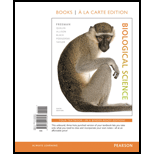
Concept explainers
CAUTION What are homologous chromosomes?
a. chromosomes that are similar in their size, shape, and gene content
b. similar chromosomes that are found in different individuals of the same species
c. the two chromatids in a replicated chromosome
d. any chromosome in a diploid cell
Introduction:
The chromosomes are the thread-like structure that carries the genetic information of an organism. They are made up of nucleic acids and proteins and are found in the nucleus of most of the living cells.
Answer to Problem 1TYK
Correct answer:
Homologous chromosomes are those chromosomes that are similar in shape and size. These chromosomes possess similar gene content and thus, code for the same characteristics.
Explanation of Solution
Explanation/Justification for the correct answer:
Option (a) is given that the chromosomes similar in their size, shape, and gene content are called homologous chromosomes or homologs. The two chromosomes come together and make a homologous pair, which comprises of same genes in the same positions within the chromosomes. It is important to note that these chromosomes are similar and are not considered to be identical.
Hence, Option (a) is correct.
Explanation for incorrect answers:
Option (b) is given that homologous chromosomes are similar chromosomes that are found in different individuals of the same species. The homologous chromosomes are specifically similar to each other in size, shape, and gene content. So, it is a wrong answer.
Option (c) is given that the homologous chromosomes are the two chromatids in a replicated chromosome. The sister chromatid are the identical duplicates, which are produced by the replication of the chromosomes. They are fused together at the same centromere and are homologous chromatids and not the homologous chromosomes. So, it is a wrong answer.
Option (d) is given that any chromosome in a diploid cell are homologous chromosomes. The diploid cell contains autosomes that are homologous to each other, but the sex chromosomes are non-homologous. Therefore, any chromosome in the diploid cell cannot be homologous chromosome. So, it is a wrong answer.
Hence, options (b), (c), and (d) are incorrect.
The chromosomes having the same shape, size, and genetic content are known as homologous chromosomes or homologs. These code for the same characteristics.
Want to see more full solutions like this?
Chapter 13 Solutions
BIOLOGICAL SCIENCE (LL)-W/MOD.MASTERING
- When does DNA replication occur during meiosis? a. during telophase b. during prophase I c. during anaphase and telophase d. during interphase before meiosis I beginsarrow_forwardGive explanation X and Y chromosomes are not homologs, but in meiosis they do pair and segregate in XY organisms to create 50% haploid gametes with an X chromosome and 50% haploid gametes with a Y chromosome. How is pairing achieved? a. Since all other homologous chromosomes pair, the remaining two chromosomes pair by default. b Pairing proteins are capable of binding to different genes on the X and Y chromosomes, which allows them to pair. c. None of the statements is correct. d. They don't actually pair. Random segregation generally ensures the X and Y chromosomes separate. e.Pseudoautosomal regions that are homologous exist at the tips of both the X and Y chromosomes, and they allow pairing.arrow_forwardWhich if these people could you reasonably expect to be a tetrachromat ? A. The mother of a male with protoanomaly B. The father of a male with deuteranomaly C. The mother of a female with tritanopia D. The father of a female with protoanomaly.arrow_forward
- Genetic recombination occurs by which process? a. independent assortment b. crossing over c. chromosome segregation d. sister chromatidsarrow_forwardWhen does chromosomal nuclear DNA, which is found inside the nucleus of a eukaryotic cell, replicate? A. All types of eukaryotic cell in a human organism replicates throughout their life span. B. It only replicates during the S phase (synthesis phase) of the cell cycle. C. The chromosomal DNA only replicates once throughout their lifetime. D. It replicates during the G1 and G2 phases of the M(mitosis) phase of Meiosis.arrow_forwardGive typing answer with explanation and conclusion Eukaryotic chromosomes are composed by __________ molecules associated with proteins, mostly some __________ proteins called _________. A) RNA, acidic, gamma-globulins B) DNA, acidic, phosphatases C) DNA, basic, histones D) RNA, neutral, kinasesarrow_forward
- Give only typing answer with explanation and conclusion Condensing are proteins that assemble onto the DNA during M phase to promote the progression of the cell cycle. What protein controls the activation of condensins?arrow_forwardGive only typing answer with explanation and conclusion A diploid species has a total of 52 chromosomes. How many chromosomes would be found in a monosomy, trisomy, and autotriploid, respectively?arrow_forwardWhat is the purpose of mitosis? a It ensures that new nuclei have an exact copy of DNA. b It ensures the reproduction of mitochondria and chloroplasts. c It guarantees that each daughter cell has half the amount of DNA of parent cells. d It prevents the occurrence of cancer cells.arrow_forward
- If the liver cells of an animal have 48 chromosomes, the sperm cells would have how many chromosomes? Question 5 options: a) 24 b) Twice the diploid number c) Half the haploid number d) 48arrow_forwardWhat are homologous chromosomes? a. The two halves of a replicated chromosome b. Two identical chromosomes from one parent c. Two genetically identical chromosomes, one from each parent d. Two genetically similar chromosomes, one from each parentarrow_forwardHow do cells after meiosis compare with cells that are in the prophase of meiosis I?A) The cells have half the number of chromosomes and one-fourth the amount of DNA.B) The cells have the same number of chromosomes and half the amount of DNA.C) The cells have half the number of chromosomes and half the amount of DNA.D) The cells have half the amount of cytoplasm and twice the amount of DNA.arrow_forward
 Biology Today and Tomorrow without Physiology (Mi...BiologyISBN:9781305117396Author:Cecie Starr, Christine Evers, Lisa StarrPublisher:Cengage Learning
Biology Today and Tomorrow without Physiology (Mi...BiologyISBN:9781305117396Author:Cecie Starr, Christine Evers, Lisa StarrPublisher:Cengage Learning

